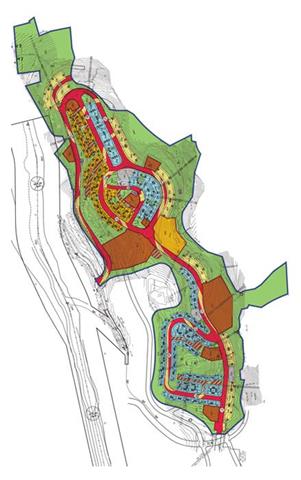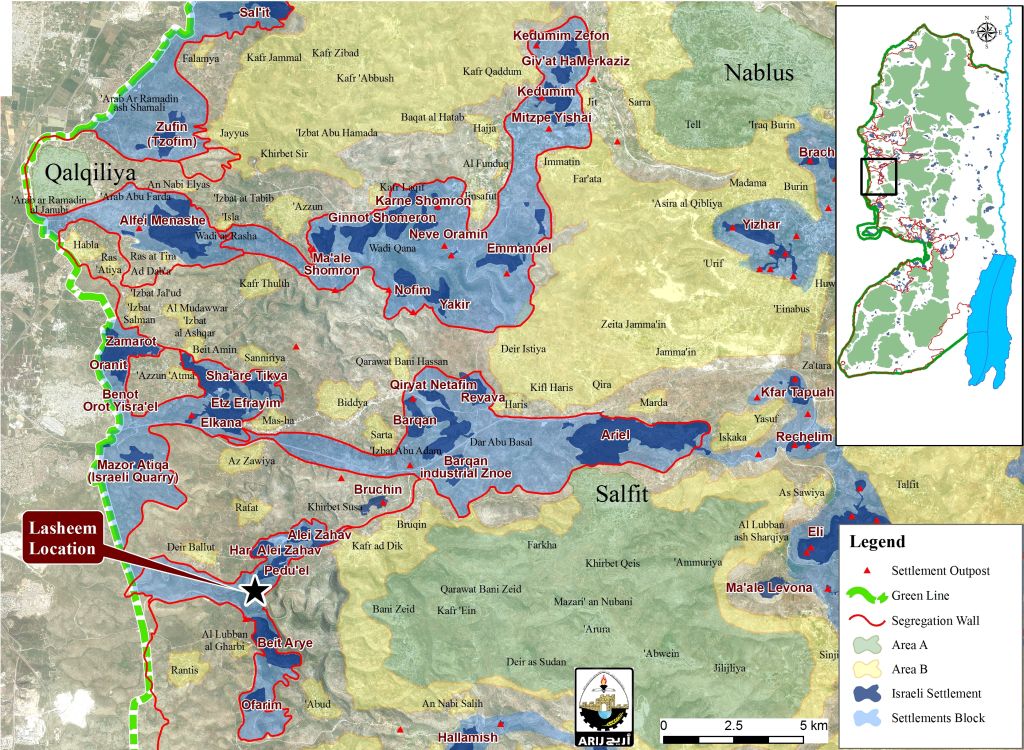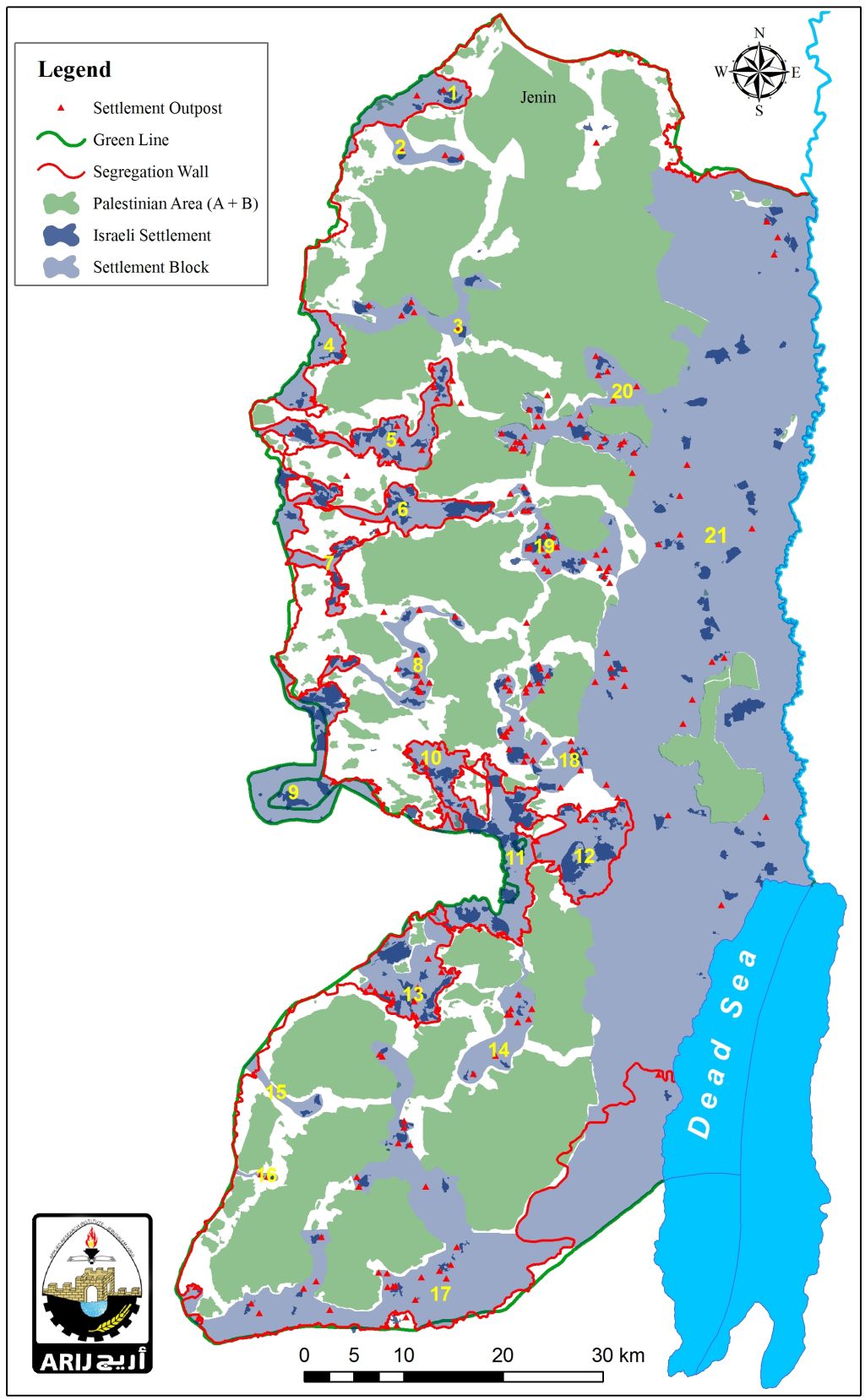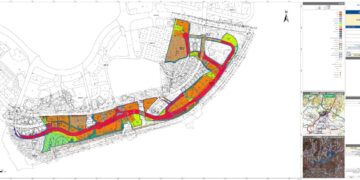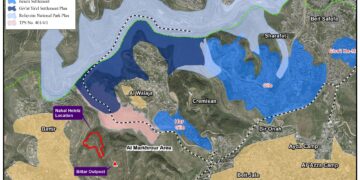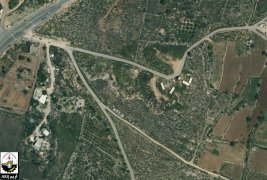On June 5, 2015, the Israeli daily newspaper “Haaretz” revealed on an ongoing Israeli construction that took place in the northern part of the West Bank to create a new settlement bloc in the area. The high pace –work in the site of what is so-called “Leshem settlement” has reached an advanced stagtes.
Leshem is an illegal Israeli settlement located to far west of Salfit Governorate and 5 km away from the Green Line (Armistice Line of 1949). It is located to the south nearby of the illegal settlements of Eli Zahav [1] and Peduel.
The Leshem settlement was constructed in 2013 on Palestinian lands from the nearby Kafr al-Dik and Deir Ballut villages, while three architectural sites in the area were damaged by construction. Today about 100 Jewish families living in Leshem settlement with much thousands expected to settle in the settlement once the 694 housing units building completed.
It is worth pointed that the Israeli occupation authorities issued the plan holding No. ( 132/6) to build 694 housing units in the settlement of Leshem on March 11, 2014 as a part of tenders issued to build 2372 housing units in (Ariel, Almog, Kochav Yacov, Giv’at Ze’ev, Shevi Shomron, Beit ‘Il, Shevut Rahel and Leshem)[2]. See Photo 1
Photo 1: Construction Plan in Leshem settlement
Source: www.ileshem.co.il
Plan No. (132/6)- Leshem settlement (Israel Land Authority)
Back to the year 2013 and on August 25th what is so-called Israeli Housing Minister, Uri Ariel, celebrated the inauguration of what was a new Israeli settlement neighborhood, “Leshem” (currently under construction – 100 units were already built that time) in Alei Zahav settlement, in Salfit Governorate. During the ceremony, the minister (Uri Ariel), stated that: the Leshem neighborhood is “Formally part of an existing settlement, but will function as a separate community for all intents and purposes, and we shouldn’t be afraid to say it" ………………."There is no way, during any negotiations, that we will not build in Jerusalem, Judea and Samaria, the Jordan Valley and all the land of Israel. Today, we are inaugurating a new community."
More than that, another statements were marked in the same ceremony: Deputy Transport Minister Tzipi Hotovely added: "It doesn’t matter if this is a settlement or a neighborhood, as long as we build more houses. It is at this time of negotiating that it is most important that more neighborhoods or settlements be built and that the Palestinians are sent a message that Israeli settlement is here to stay."
Gershon Mesika, head of what is so-called Shomron Regional Council also added : I'm telling John Kerry… you can talk and do whatever you want. We will stay here and build on all the hills around."
It is worth pointed that Leshem along with Ali Zahav , Har Eli Zahav, Peduel, Beit Arye and Ofraim , are located in an enclave inside the borders of Ariel settlement bloc[6] in the area known today to the Palestinians as the Western Segregation Zone.( An area located between the 1949 Armistice line and the route of the segregation wall. Note that Israel plans to annex this area to its current illegal and unilateral borders through the construction of the Segregation Wall. See map 1 below:
Map 1: Location of Leshem settlement
Actually the accelerated construction in the settlement of Leshem , which is actually part of the inflated settlement bloc of “Ariel” was not fortuitous.
The Israeli PM, Netanyahu, and on April 17, 2012, approved a plans to legalize three illegal settlements in the West Bank, after he get recommendations approved by the Defense Minister Ehud Barak to formalize the status of Bruchin[3], Rechalim and Sensana settlement in the West Bank”.
According to the aforementioned plan, Bruchin proposed to be part of Eli Zahav (2 km between them) and Rechalim[4] to be part of Kfar Tepouah[5] (1.5 km) while Sensana to be part of Ashkelot (2.5 km).To read more about the plan refer to the previously written case study (“Netanyahu & Peace”… In His Case….Opposites don’t Attracts .April 2012).
"Two State Solution………Israel vs. Judea & Samaria Settlement Blocs"
On May 26, 2015, the Israeli Prime Minister Benjamin Netanyahu told the European Union’s top foreign policy official (Federica Mogherini) last week that he wants to resume talks with the Palestinians, with his goal being to reach understandings on the borders of settlement blocs that Israel would annex under any peace agreement.
The systematic Israeli expansion in the illegal settlements in all parts of the oPt diametrically affect the geopolitical status in the Palestinian Territory.
As for its considerations and colonial desires, Israel had consistently created in islands and enclaves that trapped the settlements and settlement blocs to keep them with in its sovereignty in any future peace agreement.
As a matter of fact, the Israeli “Territorial” expansion strategy in the oPt have two significant aspects : capturing as much as territories by building and expanding in the illegal settlements and their closest outpost . On the other hand, imposing matrix of colonial regulations and procedures for the aim of imposing extreme development restrictions on the Palestinian communities mainly those located in Area C (constitute 60% from the total West Bank Area).
Netanyahu proposed to “jump” to a negotiations concerning the status of the settlement blocs instead of resuming peace talks to resolve all final status issues
instead of dealing with 196 illegal settlements and 232 illegal outposts spread over all parts of the occupied West Bank including East Jerusalem.
Obviously Netanyahu sought to retain into blocs finding new facts on the ground by creating more interrupt the geographical contiguity between the Palestinian communities and thus undermining a future peace agreements with the Palestinians. See map 2 below:
Map 2: Location of the settlement blocs in the oPt
Legal & International Status
Netanyahu’s denial of the International legitimacy represented by the United Nation Security Council Resolutions mainly 338 & 242, and it’s deliberately foiling any International-led efforts for the interest of reaching just and durable peace agreement with the Palestinians, shows the real face for the longest Israeli Occupation.
- UNSCR 242, adopted in November 22, 1967: Calls on Israel to withdraw from the all of the Territory it occupied in its aggression on June 5, 1967.
- Also United Nation Security Council Resolution No. 446 of 1979 calls on Israel to rescind its previous measures and to desist from taking any action which would result in changing the legal status and geographical nature and materially affecting the demographic composition of the Arab territories occupied since 1967, including Jerusalem and, in particular, not to transfer parts of its own civilian population into the occupied Arab territories'
- Also UNSCR No. 452 of 1979 “calls upon the Government and people of Israel to cease, on an urgent basis, the establishment, construction and planning of settlements in the Arab territories occupied since 1967, including Jerusalem.”
- Moreover ,UNSCR No. 465 of 1980 'called upon Israel to stop building in the Israeli settlements in the occupied territories and to dismantle all of the Israeli settlements built in the aforementioned territories since the year 1967, and demanding all of the state parties of the UN not to help Israel in building these Illegal settlements'.
- Furthermore the Forth Geneva Convention of 1949 also states in Article 49 that “The occupying power shall not deport or transfer parts of its own population into the territories it occupies.” and Article 174 of the same convention “prohibits the 'extensive destruction and appropriation of property not justified by military necessity and carried out unlawfully and wantonly.”
- Article XXXI of the 1995 Oslo agreement Israel is forbidden from building or planning to any project or settlements or any colonial expansion or any plan that lead to change the status of the West Bank and Gaza Strip. The article provides “Neither side shall initiate or take any step that will change the status of the West Bank and the Gaza Strip pending the outcome of the permanent status negotiations”.
- In May 2001, the head of the International Red Cross delegation to Israel and the Occupied Territories said that settlements are 'equal in principle to war crimes'. (Note: 'The transfer, the installation of population of the occupying power into the occupied territories is considered as an illegal move and qualified as a 'grave breach.' It's a grave breach, formally speaking, but grave breaches are equal in principle to war crimes', Rene Kosirnik, head of the ICRC delegation to Israel and the OPT, press conference 17 May 2001).
[1]Alei Zahav: Israeli settlement established in the year 1982. It occupy an area of 299 dunums and populated by 690 settlers.
[2] http://www.old.poica.org/details.php?Article=6272
[3]Bruchin: Israeli settlement established in the year 1999 on a total area of 278 and populated by 540 settlers.
[4]Rechalim: Israeli settlement founded in the year 1991 on 59 dunums pieace of land and populated by 223 settlers.
[5]Kfar Tepuah: settlement est. at 1980 and occupies an area of 651 dunums and inhabited by 1070 settlers.
[6]Ariel settlement block : located northwest of Salfit Governorate. It separates between Qalqilya and Salfit Governorates. The bloc constitutes from 18 illegal settlements of which, 14 settlement located within Salfit Governorate boundaries. It occupies an area of 53,384 dunums (26.2 % from the total area of Salfit Governorate) while inhabited by +25,000 settlers.
Prepared by:
The Applied Research Institute – Jerusalem


